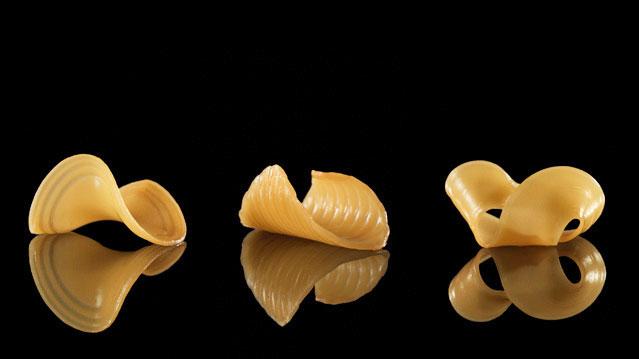tangiblemediagroup
Latest

MIT 3D-printed the shape-shifting future of pasta
A new research project from the Massachusetts Institute of Technology's Tangible Media Group combines 3D printing, molecular gastronomy and macaroni. According to MIT News, researchers Wen Wang and Lining Yao have engineered flat sheets of gelatin and starch into shape-shifting noodles that react and fold when exposed to water. While Yao's goal of one day creating a self-folding dumpling is still out of reach for now, the research team thinks their breakthrough could help reduce food shipping costs and lead to new trends in fine dining.

3D-printed hair leads to fuzzy machines and sticky blocks
A while back, MIT researchers found a way to easily create 3D-printed hair: smart software can create thousands of tiny polymer strands (smaller than 100 microns, if you want) that give objects a fuzzy texture. Now, however, they're finding practical uses for those natural-feeling surfaces. If you specify the right angles, density, height and thickness, you can make the hair do surprising things. On a basic level, you can create blocks that only stick to each other under certain conditions, or paint brushes that produce very specific effects. However, it really gets interesting when you vibrate the hairs -- you can create motors and sensors that are as baffling as they are clever.

ICYMI: Self-building bot, fresh tortillas from pods and more
#fivemin-widget-blogsmith-image-484230{display:none;} .cke_show_borders #fivemin-widget-blogsmith-image-484230, #postcontentcontainer #fivemin-widget-blogsmith-image-484230{width:570px;display:block;} try{document.getElementById("fivemin-widget-blogsmith-image-484230").style.display="none";}catch(e){}Today on In Case You Missed It: MIT's Tangible Media Lab built a shifting interface that can be used to test basic physics and even help seismologists understand the ripple fallout from an earthquake. A Kickstarter device for a tortilla-maker costing $240 irritated us enough to call on the latest environment chart made by a climate scientist. And German researchers built a robot that can build itself and our robot eek factor continues to grow. A drone performed a neat liquid trick over on YouTube and has us excited for the delivery UAVs to come! As always, please share any great tech or science videos you find by using the #ICYMI hashtag on Twitter for @mskerryd.

Shape-shifting interface lets you touch computer simulations
Researchers want us to better interact with machines via screens and VR, but let's face it, we humans like to touch real objects. MIT's Tangible Media Group has been playing with that idea for awhile now with projects like InForm, an uncanny telepresence interface. It has now taken it further with Materiable, a shape-changing interface that lets you see and even touch physical simulations. The idea is to let users visualize and interact with materials or mathematical models of things like earthquakes and landslides.

MIT's shape-shifting bot can be a phone, lamp or exoskeleton
MIT's Media Lab has created LineFORM, a "Shape Changing Interface" that presents new ways for us to interact with technology. LineFORM is a serpentine robot that has the ability to form a number of shapes, mixing flexibility with rigidity. The lab's Tangible Media Group believes it opens up "new possibilities for display, interaction, and body constraint," and has demonstrated its potential for all three on video.

ICYMI: Mars life, bendy smartphone screens and more
#fivemin-widget-blogsmith-image-427843{display:none;} .cke_show_borders #fivemin-widget-blogsmith-image-427843, #postcontentcontainer #fivemin-widget-blogsmith-image-427843{width:570px;display:block;} try{document.getElementById("fivemin-widget-blogsmith-image-427843").style.display="none";}catch(e){}Today on In Case You Missed It: It's Space Week, and today's celestial story is an earth-bound look at what a colony of humans would have to endure on Mars. People from Hawaii's Space Exploration Analog and Simulation group just finished an eight month camp-out, cut away from society and only allowed outside when clad in space suits. Not so spacey but equally fascinating, MIT scientists figured out a bendable smartphone display's chemistry. And wearable product company Lumo announced new running shorts that aim to fix your body mechanics when pounding pavement.

MIT can turn your smartphone into a different kind of second screen
Sure, we've seen apps that let you easily share files between your phone and PC. No biggie there. But the demo we're about to show you is a tad more sophisticated than that. Over at MIT, two teams of researchers have developed a smartphone system called THAW, which allows you to share files and use the phone as a game controller -- all by pressing the handset against your computer's display. As you can see in the below demo video, for instance, it's possible to transfer files onto the phone simply by dragging them where the phone is, as if it were just another folder on your desktop. Similar to what you can already do with NFC, you can press the phone against the screen, and walk away with whatever web page you had been looking at. (To be fair, iOS 8's Continuity feature does that automatically.)




